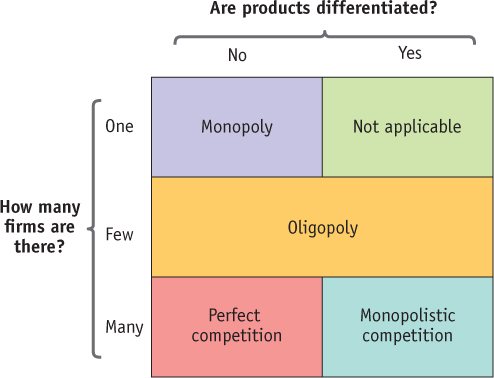Types of Market Structure
The real world holds a mind-boggling array of different markets. Patterns of firm behavior vary as widely as the markets themselves: in some markets firms are extremely competitive; in others, they seem to coordinate their actions to limit competition; and some markets are monopolies in which there is no competition at all. In order to develop principles and make predictions about markets and firm behavior, economists have developed four primary models of market structure: perfect competition, monopoly, oligopoly, and monopolistic competition.
This system of market structure is based on two dimensions:
the number of firms in the market (one, few, or many)
whether the goods offered are identical or differentiated
AP® Exam Tip
Create a chart showing the differences between the four types of market structures found in this module. These comparisons show up frequently on the AP® exam.
Differentiated goods are goods that are different but considered at least somewhat substitutable by consumers (think Coke versus Pepsi).
Figure 57.1 provides a simple visual summary of the types of market structure classified according to the two dimensions. A more detailed summary appears at the end of the module. In perfect competition many firms each sell an identical product. In monopoly, a single firm sells a single, undifferentiated product. In oligopoly, a few firms—more than one but not a large number—sell products that may be either identical or differentiated. And in monopolistic competition, many firms each sell a differentiated product (think of producers of economics textbooks).

Figure 57.1: Types of Market StructureThe behavior of any given firm and the market it occupies are analyzed using one of four models of market structure—monopoly, oligopoly, perfect competition, or monopolistic competition. This system for categorizing market structure is based on two dimensions: (1) whether products are differentiated or identical and (2) the number of firms in the industry—one, a few, or many.
